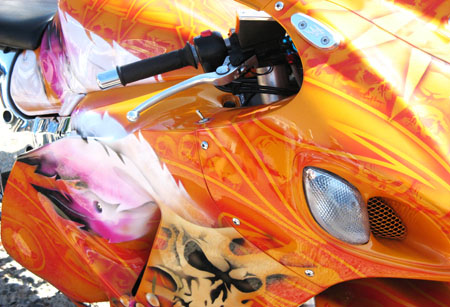
It has often been said that, when striving to improve an image, the best approach is simply to go closer! This is certainly true when seeking subjects for photographic abstract work.
The world around us is extremely varied but also very familiar. We see everyday objects and recognize them without absorbing their detail because we quiicky identify their shape, form, colour or behaviour. However, if we remove the familiarity by taking the viewer much closer to a subject, the result may be something that is interesting in its own right but not identifiable as part of the larger subject.
The image on the right shows a small part of the bodywork of a beautifully decorated motorcycle. It is not too difficult to identify the subject because familiar elements such as a handlebar, a light and part of the saddle have been incorporated. However, even when seen from this moderate distance, it is the paint job that dominates and leads the eye around the image. Had the image been taken from a much closer viewpoint, perhaps showing only the area at the lower left, the viewer would have been deprived of all knowledge of the broader subject.
In a case such as this, and in many other cases, the degree of absraction may therefore be varied at will by changing the distance from which a subject is seen. We all know that a zebra is a four-legged animal found in Africa, and it is immediately recognizable by its four legs, its size and environment, and its distinctive black and white stripes. However, zoom in on the stripes to the extent that theenvironment and the majority of the animal's body is excluded from the frame, and perhaps rotate the camera by 30 degrees, and the viewer may struggle to identify a subject that has become almost totally abstract.






